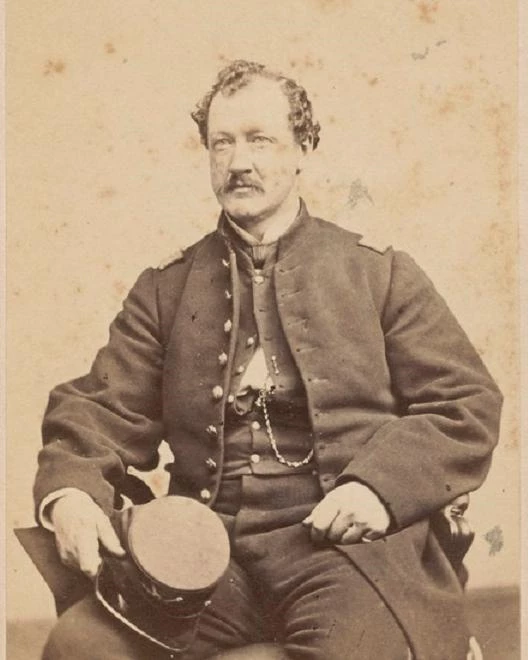Last updated: July 23, 2025
Person
Major Stephen Cabot

Courtesy of the Medford Historical Society & Museum Civil War Photo Collection.
Boston native Major Stephen Cabot had a successful mercantile business prior to the US Civil War. Joining the military, he served at Fort Warren on Georges Island. He officially took command of the Fort in 1863, holding that position through the end of the war. After the war, he returned to the mercantile business.
Born in Boston, Massachusetts, in December 1826, Major Stephen Cabot left school at the age of 16. He entered the foreign mercantile business, and established a firm called Cabot, Lee and Barstow. Cabot married Ellen Louise Keith in the 1840s, and the couple had four children together. The firm remained in operation until 1862, when it closed because of the US Civil War.1
During his time as a soldier, Cabot served at Fort Warren under Colonel Justin Dimick for 18 months. On July 14, 1863, he responded to Governor John Andrew’s orders to help quell the draft riot in Boston. With Dimick’s approval, Cabot took 166 enlisted soldiers, and noncommissioned officers from three companies stationed at the fort. Each soldier received 20 rounds of ammunition, and Cabot recalled that they made their way to the dock in less than 25 minutes after they received their orders. Once in Boston, the soldiers faced a difficult situation. Cabot recollected in his diary:
Major Jones urged me to fire blank cartridges; and said he could not be responsible for firing canister into his fellow citizens. I told him I did not intend to fire at all if it could be avoided, but if I was forced to fire, I intended to do all the damage I could, and that I alone was responsible.
As the night went on, the mob grew closer, and Cabot attempted to send relief for those bringing back wounded soldiers. When he withdrew two detachments, "this caused an excitement," and soldiers shot over the heads of the mob. Cabot later noted in his diary that he did not make such an order and was unsure if one occurred at all. The events of the draft riots resulted in many injuries, and a few deaths, though the numbers are unknown.2
When Colonel Dimick left command of Fort Warren in November 1863 due to failing health, Dimick recommended that Cabot replace him. Under Major Cabot, conditions declined for prisoners at Fort Warren. While Dimick had recommended the fort accommodate no more than 175 prisoners at a time to avoid overcrowded conditions, Cabot had other ideas. He notified his superiors in 1864, that they could accommodate nearly 600 more prisoners if they received bunk beds. Prisoners at Fort Warren during Major Cabot’s tenure complained of overcrowded casemates and food rations. When a prisoner from the CSS Atlanta wrote to Major General Ethan Allan Hitchcock criticizing the rations given to them, Hitchcock requested verification from Cabot, who responded by saying:
There have been complaints…. I find the bread is so good that some eat more than their allowance of, 18oz., and thus may deprive others of their full share.
Under Cabot, prisoners could still receive clothing with officer approval, but they could not receive food and liquor as gifts. Prisoners resented a ruling that limited what they could purchase from sutlers. Censorship of letters also increased as the war raged on. Although some of these changes came from higher up, Cabot enforced these regulations.3
Major Cabot also carried out punishment at Fort Warren as the commanding officer. In 1864, Cabot oversaw the execution of federal deserters Matthew Riley and Charles Carpenter. Suspected of being bounty jumpers, the two men faced a court martial on Gallops Island before receiving their sentence. Cabot waited as long as possible to carry out these orders, in case they were to be reprieved. But on April 22, Major Cabot informed the Department of the East that the execution had been carried out.4 Prisoners who broke disciplinary rules faced solitary confinement or other punishments. In one case, Boston newspapers reported harsh treatment of prisoners, but other reports disputed these accusations and commended Major Cabot’s kindness to the prisoners.5
Once the war ended, Major John W. M. Appleton, who had served at Fort Wagner with the 54th Massachusetts Regiment, took command of Fort Warren. Cabot returned to work in the mercantile business. He opened a new firm with M. Lincoln Bowles and eventually moved to New York. Cabot kept the business association until 1881 and retired shortly after. Cabot died in Brookline, Massachusetts in 1906.6
Footnotes:
- Lloyd Vernon Briggs, History and Genealogy of the Cabot Family, 1475- 1927, (Boston: Charles E. Goodspeed & Co., 1927), 698-699.
- Stephen Cabot, "Draft Riot" in Boston, July 14, 1863, (Boston: Veterans Association of Co. A 1st Battalion of Massachusetts Volunteer Infantry); Minor Horne McLein, "Prison Conditions in Fort Warren, Boston, During the Civil War," (unpublished dissertation, 1955), 55-56.
- McLein, "Prison Conditions in Fort Warren, Boston, During the Civil War," 227-239.
- McLein, "Prison Conditions in Fort Warren, Boston, During the Civil War," 55- 56; "Abraham Lincoln to Stephen Cabot, 20 April 1864," in Collected Works of Abraham Lincoln, Volume 7 (University of Michigan, 1953); "Abraham Lincoln to John. A Dix, 21 April 1864," in Collected Works of Abraham Lincoln, Volume 7 (University of Michigan, 1953).
- McLein, "Prison Conditions in Fort Warren, Boston, During the Civil War," 246-247.
- James Robbins Jewell and Eugene S. Van Sickle, "New Firsthand Account of the 54th’s Assault on Fort Wagner," last modified, July 18, 2022, accessed April 27, 2023; Briggs, History and Genealogy of the Cabot Family, 1475- 1927, 698-699.
